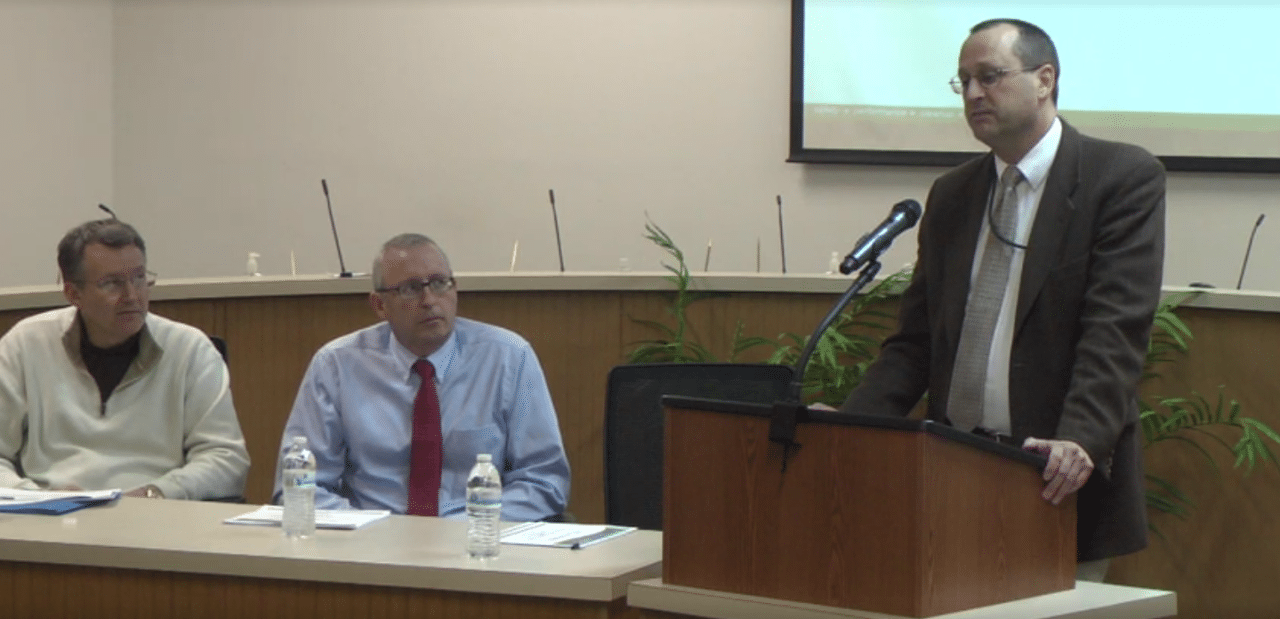
The Energy Department will not commit to reopening the Waste Isolation Pilot Plant (WIPP) by Dec. 31, an agency official told local stakeholders Thursday.
“Our goal, based on everything we know, continues to be December,” Todd Shrader, head of DOE’s Carlsbad Field Office, said in a town hall meeting webcast from Carlsbad, N.M., some 40 miles west by road from the still-shuttered transuranic waste storage facility. “If it takes a little bit beyond that, we will take the time.”
WIPP has been closed for nearly three years following an accidental underground radiation release from an improperly packaged waste barrel, and an earlier, unrelated underground fire. The deep-underground salt mine is the only permanent disposal facility for transuranic waste: a DOE designation for material and equipment contaminated by elements heavier than uranium during Cold War-era manufacture of nuclear-weapons and other Pentagon hardware.
Earlier this year, DOE said it planned to reopen WIPP by Dec. 12. Still, the agency and site contractor Nuclear Waste Partnership (NWP) are now in the final stages of the protracted recovery.
Two major hurdles remain: securing approval to resume waste disposal from the New Mexico Environment Department, which issued WIPP’s operating permit to DOE and NWP, and fixing 21 punch-list items a group of DOE experts discovered in a two-week review of WIPP that wrapped up Dec. 2.
The state’s final report on a review concluded last week should arrive in the “near future,” Shrader said.
NWP President and Project Manager Philip Breidenbach said DOE has, in the past two weeks, signed off on fixes for six of the 21 items it identified for correction. That left 15 of these so-called corrective actions to go with only 16 more days left in December, as of Thursday.
Some of the items on DOE’s pre-start punch list require only paperwork fixes, Ed Westbrook of DOE’s Operational Safety Office in Denver said at the town hall. Westbrook led the DOE inspection team.
Other findings, however, will require more attention and effort from the department and its contractor. For example, Westbrook’s team found DOE still does not have “an effective process in place to ensure a consistent, timely, and appropriate level of radiological personnel response to radiological events,” such as the radiation leak that closed WIPP in the first place.
Once WIPP reopens, it will take two or three months at least before the facility is ready to accept new shipments of transuranic waste from across a DOE complex that is sitting on a significant backlog of such material.
In any case, waste containers that were marooned above-ground at WIPP when the mine closed in 2014 are first in the queue for the underground. Shrader said about two-thirds of the waste containers in the Waste Handling Building on WIPP’s surface have been certified according to strict new waste acceptance criteria rolled out in July and are ready for interment now. The remainder should be certified for burial once WIPP reopens, Shrader said.
WIPP will take about five waste shipments a week once it is ready to accept material from off-site, DOE has said. Prior to the 2014 accidents, the mine accepted more than 15 shipments a week.
Nearly 55,000 cubic yards of contact-handled transuranic waste is stored across eight sites in the agency’s nuclear complex, plus almost another 5,000 cubic yards of the more dangerous, more radioactive remote-handled transuranic waste at 10 DOE nuclear sites, according to the 2015 Annual Transuranic Waste Inventory Report — the most current data available publicly. WIPP’s Waste Handling Building can hold roughly 50,000 square feet of transuranic waste.
Meanwhile, WIPP’s underground storage space will be smaller when it reopens. Besides closing down the mine’s southern end after repeated rockfalls there earlier this year, NWP has decided to abandon one of the rooms in a still-useful waste-disposal area known as Panel 7.
In November, part of the ceiling collapsed in Room 4 of Panel 7. The contractor foresaw the collapse, but the damage was evidently expansive enough that NWP and DOE decided not to use the room for waste disposal in the near future.
“We plan not to recover it,” Breidenbach said of Panel 7’s Room 4. He added, however, that clearing out the room and reclaiming the space might be possible in the future.
Room 7 of Panel 7 contains the inappropriately packaged barrel of nitrate salts from the Los Alamos National Laboratory that blew open underground in February 2014. That room will be sealed off.
After questions about a December reopening from some audience members at Thursday’s town hall, Breidenbach and Shrader stayed on message about getting the mine open this year. One audience member pressed the pair further, asking whether NWP might receive a payment from DOE for reopening the mine by a certain date.
Breidenbach quickly quashed the notion.
“There are no bonuses for us tied to the restart of WIPP on a particular date,” Breidenbach said. A management strategy like that, the 30-year nuclear hand added, would be “mad.”